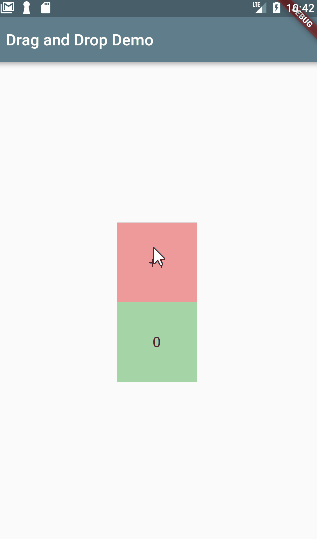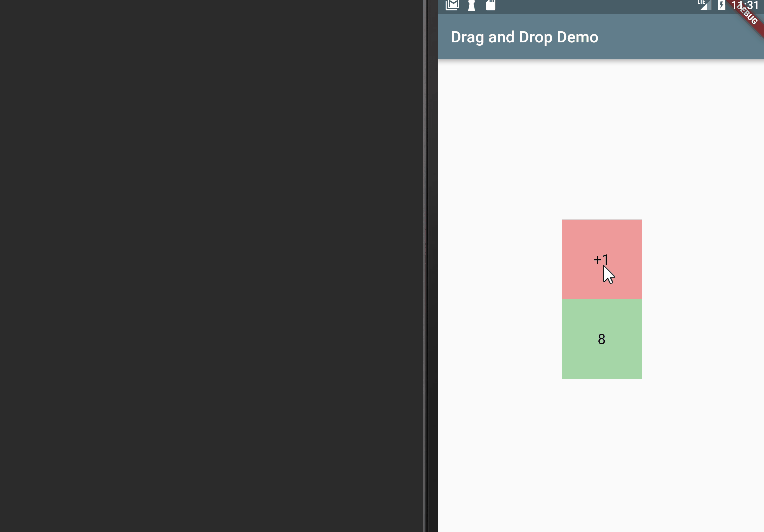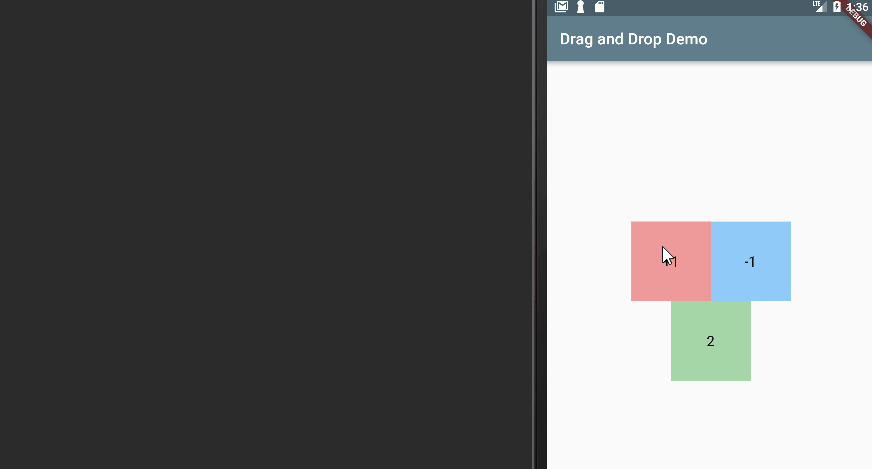Flutter : การทำลาก-วาง (Draggable) ใน Flutter
สวัสดีทุกท่าน ช่วงนี้ผมมีโปรเจคคิดว่าจะทำเล่นๆไปเรื่อยๆ แล้วมีโปรเจคนึงคิดว่าต้องใช้การลาก วาง widget ในแแอป วันนี้ก็เลยลองเล่นเกี่ยวกับ การทำ ลาก-วาง (draggable) บน Flutter ครับ เลยมาเขียนสรุปคร่าวๆในบล็อกนี้
เริ่มต้น
เตรียมตัวให้พร้อม
new Flutter Project
Draggable Widget
Draggable เป็น Widget ที่เมื่อนำมาครอบ Widget อื่น Widget นั้นก็จะลากได้ ง่ายๆแค่นี้แหละ
โดยมี ลูกเล่นหลักๆ 3 อันคือ
child = View ลูกที่แสดงตอนยังไม่ได้ถูกลาก
feedback = View ที่แสดง ขณะกำลังถูกลากไปพร้อมกับเรา
vhildWhenDragging = View ลูกที่แสดงขณะกำลังถูกลากอยู่
@override
Widget build(BuildContext context) {
return Scaffold(
appBar: AppBar(
title: Text(widget.title),
),
body: Center(
child: Column(
mainAxisAlignment: MainAxisAlignment.center,
children: <Widget>[
Draggable(
child: buildBox("child", Colors.red[200]),
feedback: buildBox("feedback", Colors.yellow[200]),
childWhenDragging:
buildBox("childWhenDragging", Colors.blue[200]),
),
],
),
), // This trailing comma makes auto-formatting nicer for build methods.
);
}
Container buildBox(String title, Color color) {
return Container(
width: 200,
height: 200,
color: color,
child: Center(child: Text(title, style: TextStyle(fontSize: 18,color: Colors.black))));
}
เพื่อความเข้าใจ ผมลองสร้าง Container แล้วลองเพิ่ม Draggable ให้มัน
ดังนั้นถ้าอยากให้มันเหมือนกำลังถูกลากไปจริงๆ ก็ไม่ต้องใส่ childWhenDragging
Draggable(
child: buildBox("child", Colors.red[200]),
feedback: buildBox("feedback", Colors.yellow[200]),
childWhenDragging:Container(),
)
โดยเราสามารถกำหนดให้ลากได้เฉพาะแนวตั้งหรือแนวนอนก็ได้
โดยใช้ axis
Draggable(
axis: Axis.vertical,
child: buildBox("child", Colors.red[200]),
feedback: buildBox("feedback", Colors.yellow[200]),
childWhenDragging:Container(),
)
อีกอันที่น่าจะมีประโยชน์คือ dragAnchor มันก็คือการระบุว่าจะให้แสดง feedback ตรงไหน
โดยปกติจะมีค่าเป็น DragAnchor.child แต่ถ้าเรากำหนดแบบ pointer มันจะแสดง feedback ตรงตำแหน่งที่เรากดแทน
Draggable(
dragAnchor: DragAnchor.pointer,
...
Draggable listener
ลูกเล่นเพิ่มเติม คือ Listener ของ Draggable ซึ่งสามารถทำได้หลายอย่าง เช่น
onDragStarted = ถูกเรียกเมื่อเราเริ่มลาก
onDragCompleted = ถูกเรียกเมื่อเราลากแล้ว Target ยอมรับ เดี๋ยวจะพูดถึงในหัวข้อถัดไป
onDragEnd = ถูกเรียกเมื่อ เราวางแล้ว ไม่ว่าจะ Target ยอมรับหรือไม่
onDraggableCanceled = ถูกเรียกเมื่อ ลากไปวางในที่ๆ Target ไม่มี หรือไม่ถูกยอมรับ
Draggable(
child: buildBox("Hello", Colors.red[200]),
feedback: buildBox("Draging..", Colors.red[200]),
childWhenDragging: buildBox("", Colors.grey[300]),
onDragStarted: (){
print("onDragStarted");
},
onDragCompleted: (){
print("onDragCompleted");
},
onDragEnd: (details){
print("onDragEnd = "+details.wasAccepted.toString());
},
onDraggableCanceled: (Velocity velocity, Offset offset){
print("onDraggableCanceled");
},
)
ลองดู Cycle คร่าวๆ
โดยตัว onDragEnd จะมี details ส่งมาให้ด้วย ซึ่งก็เช็คได้หลายอย่าง เช่น Target ยอมรับหรือไม่
ระยะทาง ตำแหน่งที่วางสุดท้าย
onDragEnd: (details){
print("onDragEnd Accept = "+details.wasAccepted.toString());
print("onDragEnd Velocity = "+details.velocity.pixelsPerSecond.distance.toString());
print("onDragEnd Offeset= "+details.offset.direction.toString());
}
หลายคน ถ้าใหม่ๆอาจจะสงสัยว่า เราจะรู้ได้อย่างไรว่า callback ที่มันส่งกลับมามี argument อะไรบ้าง
วิธีการก็คือ กดเข้าไปดู Definition ของมัน (Ctrl+คลิก) เช่น onDragEnd ก็กดเข้าไปดูว่ามันเป็น Function แบบไหน
Draggable Data
อย่างที่เรารู้กันว่า การที่เราลาก object ก็เพราะเราต้องการทำอะไรบ้างอย่าง ดังนั้นมันก็ต้องมีจุดหมายของการลาก และการที่จุดหมายนั้นจะรู้ว่าเราลากอะไรไปวาง มันก็ต้องมีข้อมูลติดไปด้วย
draggable สามารถกำหนดข้อมูลไปกับมันได้ โดยใช้ data
Draggable(
data: 1,
...
Drag Target
พอทำให้ widget ลากได้แล้ว ก็ต้องมีจุดหมายที่รออยู่ (Target)
โดยตัวอย่างนี้ผมจะทำ widget สองตัว โดยลากตัวนึงแล้วจะ +1 แสดงผลที่ widget อีกตัว
class _MyHomePageState extends State<MyHomePage> {
int count = 0;
...
เตรียม Draggable กำหนด data เป็น 1
Draggable(
child: buildBox("+1", Colors.red[200]),
feedback: buildBox("+1", Colors.red[200]),
childWhenDragging:buildBox("+1", Colors.grey[300]),
data: 1
)
ต่อมาก็ทำ DragTarget โดยตัวละครสำคัญของมันคือ
builder = Widget ที่แสดง
candidateData = ข้อมูลที่ถูกยอมรับเข้ามา
rejectdData = ข้อมูลที่ไม่ยอมรับ
onWillAccept = ตรวจสอบว่า ข้อมูลที่รับมาจาก Draggable ตรงกับที่ต้องการหรือไม่
onAccept = ยอมรับ แล้วทำอะไร
DragTarget(
builder: (BuildContext context, List<int> candidateData,
List<dynamic> rejectedData) {
// build widget target with data.
},
onWillAccept: (int data) {
// when decide Accept or Reject.
},onAccept: (int){
// when accept the data.
},
)
สิ่งที่ผมจะทำก็คือ builder ก็ return Widget แสดง count
onWillAccept ก็เช็คว่า ข้อมูลตรงมัย ในที่นี้คือ ต้องมีค่า = 1
onAcept เมื่อยอมรับแล้วก็ + ค่าให้กับ count
DragTarget(
builder: (BuildContext context, List<int> candidateData,
List<dynamic> rejectedData) {
return buildBox("$count", Colors.green[200]);
},
onWillAccept: (int data) {
return data == 1; // accept when data = 1 only.
},
onAccept: (int data) {
count += data;
},
)
ลองรัน
ที่เหลือ listener ของ DragTarget อีกอันคือ
onLeave = เมื่อลาก widget ออกจาก Target
DragTarget(
builder: (BuildContext context, List<int> candidateData,
List<dynamic> rejectedData) {
print("candidateData = " + candidateData.toString()+" , rejectedData = " + rejectedData.toString());
return buildBox("$count", Colors.green[200]);
},
onWillAccept: (data) {
print("onWillAccept");
return data == 1; // accept when data = 1 only.
},
onAccept: (data) {
print("onAccept");
count += data;
},
onLeave: (data) {
print("onLeave");
},
)
ลองดู cycle ของ DragTarget
ทีนี้ลองทำ Draggble เพิ่มอีกตัว คือ data มีค่า -1
@override
Widget build(BuildContext context) {
return Scaffold(
appBar: AppBar(
title: Text(widget.title),
),
body: Center(
child: Column(
mainAxisAlignment: MainAxisAlignment.center,
children: <Widget>[
Row(mainAxisAlignment: MainAxisAlignment.center, children: <Widget>[
Draggable(
child: buildBox("+1", Colors.red[200]),
feedback: buildBox("+1", Colors.red[200]),
childWhenDragging: buildBox("+1", Colors.grey[300]),
data: 1,
),
Draggable(
child: buildBox("-1", Colors.blue[200]),
feedback: buildBox("-1", Colors.blue[200]),
childWhenDragging: buildBox("-1", Colors.blue[300]),
data: -1,
)
]),
DragTarget(
builder: (BuildContext context, List<int> candidateData,
List<dynamic> rejectedData) {
return buildBox("$count", Colors.green[200]);
},
onWillAccept: (data) {
print("onWillAccept");
return data == 1 || data == -1; // accept when data = 1 only.
},
onAccept: (data) {
print("onAccept");
count += data;
},
onLeave: (data) {
print("onLeave");
},
)
],
),
),
);
}
สุดท้ายลองมาดู ภาพรวม cycle ของ Draggable + DragTarget ครับ
จบแล้ว
บล็อกนี้เป็นพื้นฐานการทำ Draggable ใน Flutter ครับ จะเห็นว่าทำ draggable ทำได้ง่ายมาก หวังว่าบล็อกนี้จะมีประโชน์ครับ (:
โค้ดทั้งหมดอยู่ที่ Gist Github
https://gist.github.com/benznest/a784012f046efed6ee214481f0fb7def












 Previous Post
Previous Post Next Post
Next Post